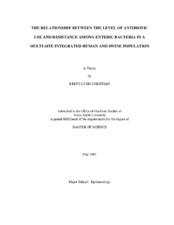| dc.description.abstract | The objective of this longitudinal study was to study the relationship between changes in prevalence of resistant enteric bacteria associated with mean monthly doses (MMD) of various antibiotics used in each of two host species. From January 2004 – January 2007, monthly composite swine fecal samples and human wastewater samples representing various production and occupational cohorts, respectively, were collected from 19 geographically unique locations in east- and south-central Texas. Bacterial isolates cultivated on CHROMagar-E.coliTM and DifcoTM mEnterococcus (ME) were tested for susceptibility to multiple antibiotics by microbroth dilution using the SensititreTM system. The relationship between the prevalence of resistant bacteria, sampling period, and antibiotic use within each host species was assessed in a generalized linear model adjusted for the dependence of responses within location using a binomial distribution and logit link function in STATA® ver. 9.2. For the swine E. coli isolates, the relationship between tetracycline resistance and level of chlortetracycline (CTC) use in swine illustrated a dose-response relationship, with odds ratios (OR) of 1.20 and 1.81 (P < 0.05) for second- and third-level categories of MMD relative to baseline (zero-use) respectively. When considered by swine production groups, intake boar isolates had an elevated relative odds of resistance to tetracycline (OR = 1.51, P < 0.05), and the nursery units had an elevated odds (OR = 2.61, P < 0.05) of exhibiting resistance to ceftiofur, relative to pigs housed in the farrowing barns. Regarding swine Enterococci isolates, those swine from locations that utilized tylosin had an elevated OR of 3.54 (P < 0.05) of exhibiting resistance to tylosin, relative to those locations that used no tylosin. At this juncture, an apparent occupational risk of harboring tetracycline-resistant E. coli, and the apparent sparing effect (Enterococcus spp.) associated with exposure to swine production, remain unexplained. This study demonstrated that the prevalences of tetracycline- and tylosin-resistant enteric bacteria swine were dependent on CTC and tylosin use in feed, respectively. Swine production group-effects on the prevalence of tetracycline, ceftiofur, and erythromycin resistance were also important. This study provides a better understanding of the relationships between antibiotic prescribing practices at the ecologic level and the relative odds of carriage of resistant bacteria within two host species in a vertically integrated agri-food system. | en |


